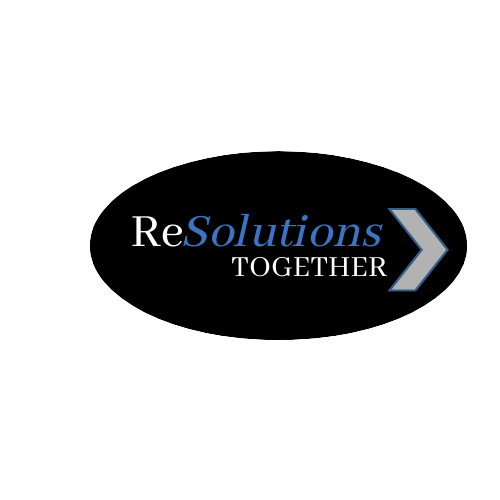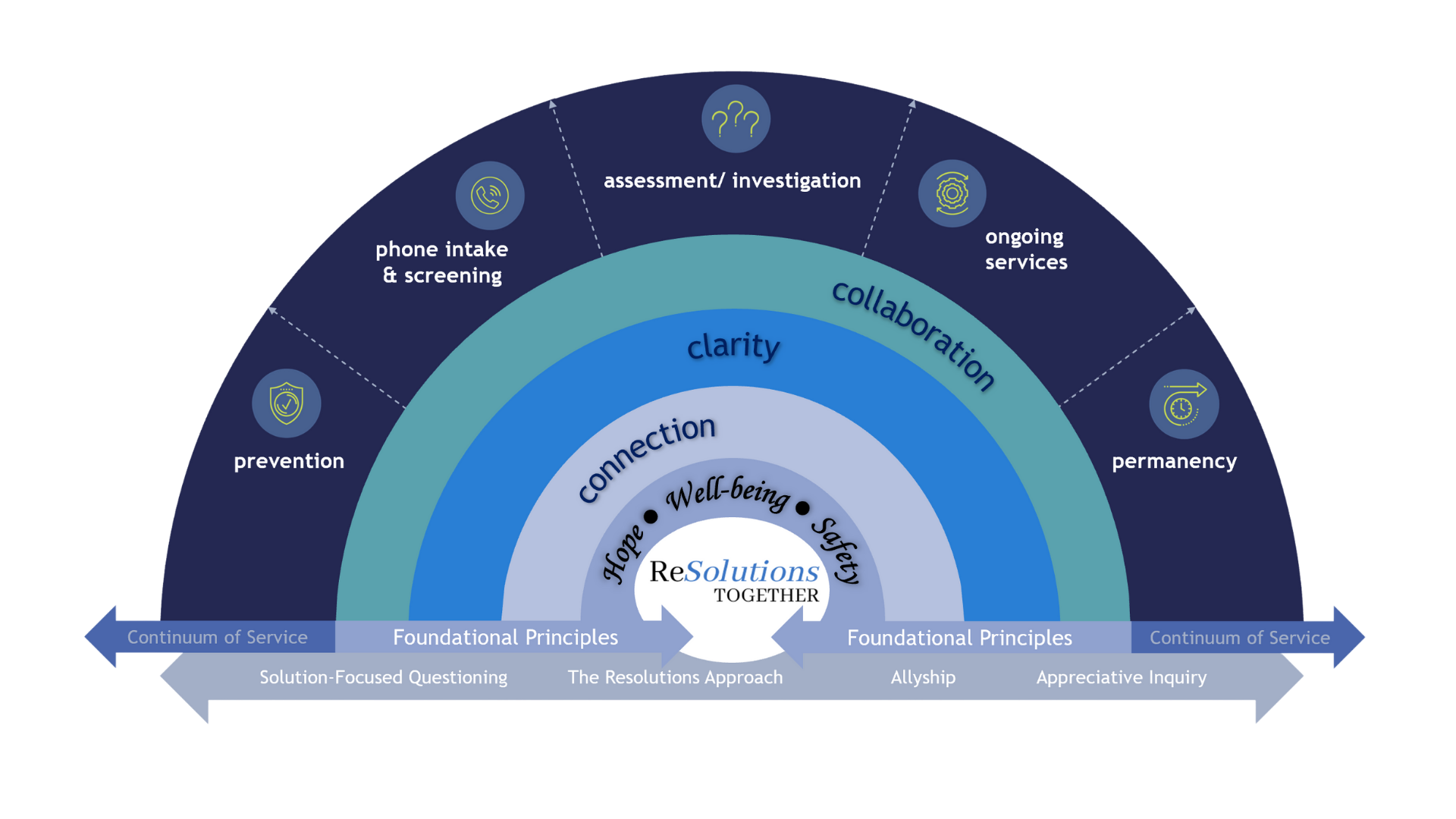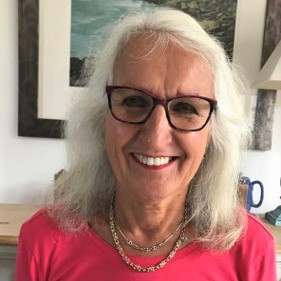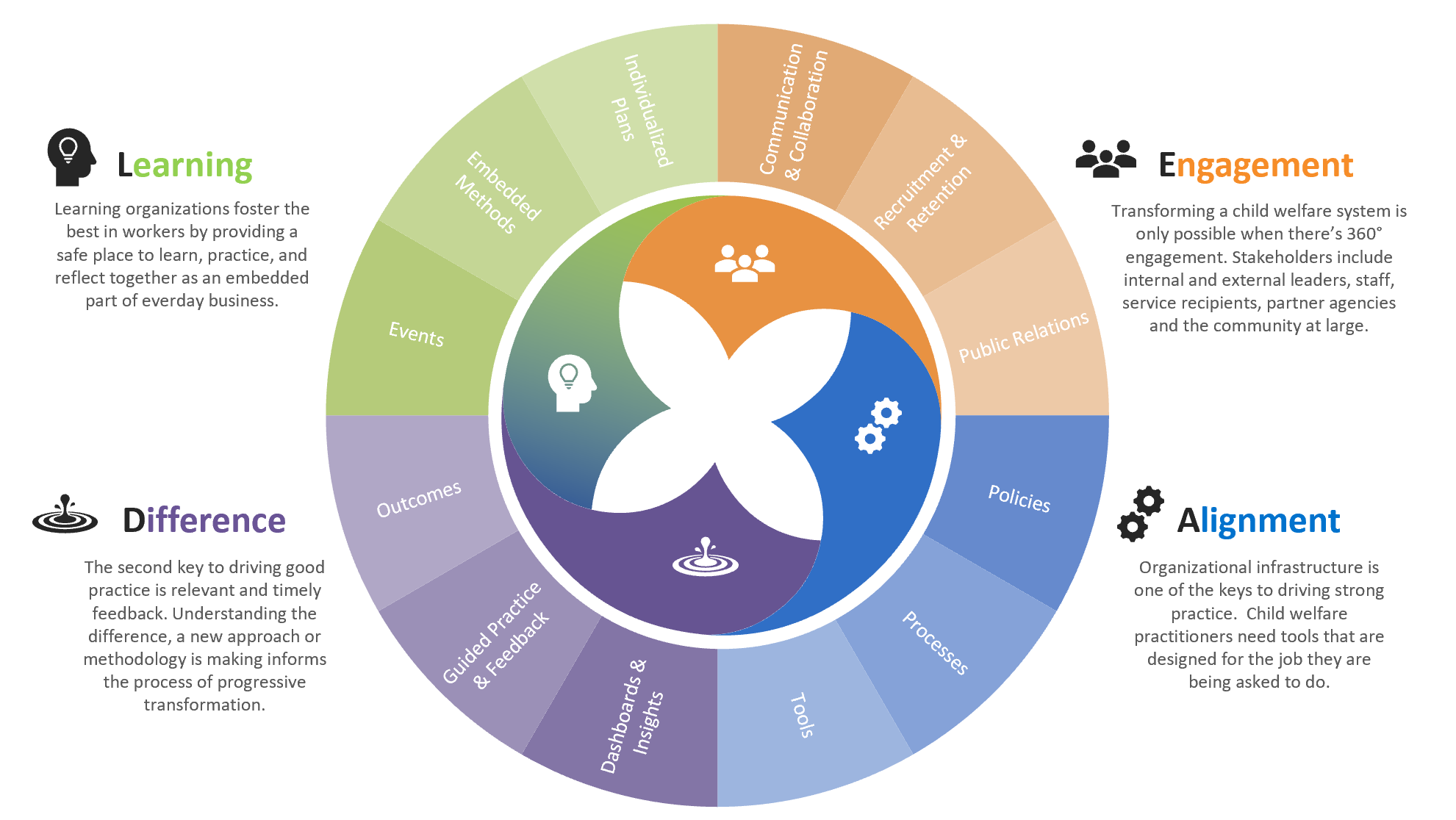Move forward with purpose, vision, and clarity
Connect your teams and goals with a proven practice approach.

How Much More Can Your Clients Achieve with the Right Framework?
Having a consistent practice framework throughout a child welfare organization is no easy task. ReSolutions Together starts with foundational principles and core processes that apply to any area of practice. Then, the ReSolutions Together tools support the practice from the first phone call through to permanency. The tools are easily adaptable to any area of practice.
Build Trust in Families with a Consistent Experience
Give the families in your community peace of mind with consistent service delivery across your organization. Unified under a single practice model, you can create better long-term outcomes for families with less repeat maltreatment and fewer agency resources.
Empower Leaders to Affect Change at Every Level
The real impact in your child welfare organization begins at the top. Leaders invested in being the change can create buy-in among staff and propel positive momentum with a custom practice approach that touches the whole organization and beyond.
For Your Organization…
Front-line Professionals
Take the burden off your staff
and prevent burn-out
Supervisors
Empower your teams
with a focused direction
Leaders
Cast a vision
and build on it
…And Beyond
Children
Foster trust and communication
to prioritize safety
Families
Give families the resources they need
with a well-oiled machine
External Stakeholders
Set clear expectations
across initiatives
Discover what a custom practice approach can do for your organization with a free organizational assessment
Forge Connections to Create Child Safety in the ReSolutions Together Practice Approach
Equip your team with a foundation of guiding principles, practical tools, and realistic processes based on tested methods from the field. With a family-wellbeing approach, our custom practice model empowers you to create hope, wellbeing, and safety by integrating your organization’s aspirations and equity efforts into one consistent practice.
Core Practice Tenants and Tools
Connection
Meet children and families where they are to build trust when and how they need it most in a system focused on child and family wellbeing.
- Genogram
- Sharing an Ongoing Assessment
- Gathering Perspectives
- Conversation Note
- Shared Ratings of Safety & Wellbeing Over Time
- Involving the Children with:
- 3 Houses
- Network Meeting Feedback & Dashboard
- Family Feedback & Dashboard
Clarity
Practical tools enable your staff and natural networks to move past conflicting perspectives through deeper critical thinking and asking rather than telling.
- Maintaining the Ongoing Assessment through Assessment Summaries, including:
- Past Worries
- Past Success
- Critical Worries
- Essential Goals
- Involving the Children with Words & Pictures™ Explanations
- Network Safety Scale & Dashboard
Collaboration
Forge and maintain ongoing family relationships with intentionality, backed by the full support of natural networks and family resources.
- Involving the Children with:
- Safety House
- Safety Object
- Words & Pictures(TM) Safety Plans
- Actively Involving Natural Networks
- Family Safety Circles
- Network Member Self-Reflection Tool
- Ongoing Safety Network Meetings
- Network Meeting Feedback
- Safety & Wellbeing Journal
- Rigorous Planning for Safety & Wellbeing
- Stressors & Triggers
- Warning Signs
- Prevention Plan Rules
- Response Plan Rules
- Practicing, Monitoring & Refining Over Time

It’s time for more hope, wellbeing, and safety.
Making a Difference Together
We applied our 70+ years of combined child welfare experience to the Resolutions Approach by Susie Essex to bring you ReSolutions Together: the custom practice approach centered around child safety.
“I’ll emphasize again and again – for me the Resolutions Approach is all about building relational resilience.
That’s the bit I want for children. They know what the worries are, they know who to talk to, and they know there’s people who will take them seriously. Really – for any child – that’s what you need in life.“
– Susie Essex, BA Hons, CQSW, DSA, DASS

Susie is also the co-author of one of the Top 5 Child Welfare Books
The Resolutions Approach:
Working with ‘Denied’ Child Abuse
Designed by Leaders in Child Welfare
Our team knows firsthand what it takes to make meaningful change throughout a child welfare organization, starting at the frontline. More than 70 child welfare jurisdictions across North America have trusted SafeGenerations for consultation and training.
Certainly Curious
We explore different perspectives to grow connection and inclusion.
Wisely Compassionate
We extend care and empathy to our partners and the people they serve.
Gracefully Rigorous
We are allies who tackle the tough stuff and honor all people while we do.
Humbly Bold
We lead with strong vision while recognizing that we always have room to grow.
Joyfully Serious
We have fun while honoring the core purpose of the significant work we do.
A Clear Framework For Implementation: L.E.A.D.

Built on 40 Years of Child Welfare Best Practices
Expand for a List of References
| Bentovim. A. (as cited in Reder, P., Duncan, S., & Lucey, C., 2003. Studies in the Assessment of Parenting. East Sussex, England: Brunner-Routledge.) |
| Boffa, J. & Podesta, H. (2004). Partnership with families and risk assessment in child protection practice, Protecting Children, 19(2): 36–48. Caslor. |
| Brown, Brene. 2018. Dare to Lead. London, England: Vermilion. |
| Child Welfare Information Gateway. (2020). Protective factors approaches in child welfare. Washington, DC: U.S. Department of Health and Human Services, Administration for Children and Families, Children’s Bureau. |
| Covey, S. (2004). The 7 Habits of Highly Effective People: Powerful Lessons in Personal Change. New York, NY: Free Press |
| Dale, P., Green, R., & Fellows, R., (2005). Child Protection Assessment Following Serious Injuries to Infants: Fine Judgements. Hoboken, New Jersey: Wiley. |
| Davis, T. (2020, April 8). 5 Reasons Clarifying Values Brings Hope in Crisis. Retrieved from http://yourpositivitycoach.com/5-reasons-clarifying-your-values-brings-hope-in-crisis/ |
| DeJong, P. & Berg, I. (2008). Interviewing for Solutions (3rd ed.). Belmont, CA: Brooks/Cole. |
| DeSanto, P. (2012). Effective Addiction Treatment: The Minnesota Alternative. MN, PaulaDeSanto |
| Essex S., & Gumbleton J. (1999). “Similar but Different“ Conversations. Australian and the New Zealand Journal of Family Therapy, 20(3). |
| Essex S., Gumbleton J., & Luger C. (1996). Resolutions; Working With Families Where Responsibility for Abuse is Denied. Child Abuse Review, 5, 191-202. |
| Essex S., Gumbleton J., & Luger C. (1998). Place of safety?. Community Care, 1232, 23-29. |
| Essex S., Gumbleton J., Luger C., & Lusk A. (1997). A suitable case for treatment? Community Care, 1159, 20-26. |
| Essex, S. (2010). Working With Denied/Disputed Child Abuse Concerns: The Resolutions Approach [PowerPoint slides]. |
| Forcehimes, A., Miller, W., & Zweben, A. (2011). Treating Addiction, A Guide for Professionals. New York, NY: The Guilford Press |
| Furniss, T. (2013). The multiprofessional handbook of child sexual abuse: Integrated management, therapy, and legal intervention. London: Routledge. |
| Geertz, C. (2000). Available light: Anthropological reflections on philosophical topics. Princeton University Press. |
| Good News Network. (2020). Positive Outlook Predicts Less Memory Decline, Says New Research. Association for Psychological Science. |
| Gumbleton J. (2004). The Reunification of Children in Serious Child Protection Cases. Context, 74, 2-5. |
| Gumbleton J., & Lusk A. (1999). Child Abuse; Rehabilitation Without Admission-A New Way Forward. Family Law, 29, 822-825. |
| Gumbleton J., Untreatable families? Working with “denial” in cases of severe child abuse, MSc Dissertation, unpublished. |
| Hiles M., & Luger C. (2006) The Resolutions Approach: Working with “Denial” in Child Protection Cases. Journal of Systemic Therapies, 25, 24-37. |
| Hiles M., Essex S., Fox A., & Luger C. (2008) The Words and Pictures Storyboard: Making Sense for Children and Families. Context, 97, 13-19. |
| Merck, Amanda. (2018, February 6). 4 Ways Childhood Trauma Changes a Child’s Brain and Body. Retrieved from https://salud-america.org/4-ways-childhood-trauma-changes-childs-brain-body/ |
| Niemand, A. (2018, May 10). Science of Story Building: Narrative Transportation. Retrieved from https://medium.com/science-of-story-building/science-of-story-building-narrative-transportation-923b2701e286 |
| Parker, S. (2011). Involving children and families: Tools and processes for working collaboratively with children and families. Handouts for the training with Connected Families and Sonja Parker; September 2011. |
| Reilly, T. (2020). Ted Lasso’s Tips for Managing Conflict. Curious. https://medium.com/curious/ted-lassos-tips-for-managing-conflict-7a9478232d96 |
| Roberts, Y. H., Shimshock, S., O’Brien, K., Claps, M., Cabrera, J., & Rozanski, T. (2018). From Data to Practice: The Impact of Placement with Family on Safety, Permanency, and Well-Being. Casey Family Programs: https://caseyfamilypro-wpengine.netdna-ssl.com/media/1896-CS-From-Data-to-Practice-2018.pdf |
| Schein, E. (2013). Humble Inquiry: The Gentle Art of Asking Instead of Telling. San Francisco, CA: Berrett-Koehler Publishers, Inc. |
| Schwantes, M. (2018, April 3). 8 Successful Mental Habits to Defeat Fear, Worry, and Anxiety. Retrieved from https://www.inc.com/marcel-schwantes/8-mental-hacks-that-will-keep-you-strong-under-control-during-tough-times.html |
| Small, T. Brain Bulletin #47- The Science of Hope. Retrieved from https://www.terrysmall.com/blog/brain-bulletin-47-the-science-of-hope |
| Smith, Emily E. (2014, October 29). Social Connection Makes a Better Brain. Retrieved from https://www.theatlantic.com/health/archive/2013/10/social-connection-makes-a-better-brain/280934/ |
| Turnell, A. & Essex, S. (2006). Working with ‘Denied’ Child Abuse: The Resolutions Approach. Buckingham., UK: Open University Press. |
| Waldman, M.R. (2015, June 7). Why Hope May Be the Most Important Thing For Your Brain, Neuro-Exercises, Health, Happiness. Retrieved from http://www.mindfullyalive.com/blog/2015/6/7/why-hope-may-be-the-most-important-thing-for-your-brain |
| Wave Trust. (n.d). What are adverse childhood experiences? https://www.wavetrust.org/adverse-childhood-experiences#:~:text=Adverse%20childhood%20experiences%20(ACEs)%20are,to%20a%20%E2%80%9Csafe%E2%80%9D%20state. |
| Weld, N., Parker, S. (n.d.). Using the ‘Three Houses’ Tool. Perth, Western Australia: Partnering for Safety. Available at: https://www.partneringforsafety.com/store/p22/Three_Houses_booklet.html |
Frequently Asked Questions
Guided How long does it take to get started with a custom practice approach?
While it depends on the size and structure of your organization, our experienced team will guide you through each step of the process. Getting started with the ReSolutions Together practice model typically takes between 8-12 weeks.
How can I measure the impact of the custom practice approach?
In addition to your current goal-tracking methods, we recommend using our Guided Practice Tools to help you measure progress in real-time.
Is my organization too big, too small, or too siloed for a consistent practice approach?
There’s no such thing as the “right size” to benefit from the ReSolutions Together practice model. While the inner workings of each organization are unique, we’ve found that the core principles to a successful practice are universal. During implementation, we’ll determine the best way to customize the approach specifically for your organization’s processes and terminology.
Isn’t implementing a new practice approach just more work?
Trying to balance competing initiatives creates confusion that holds your organization back. Investing the time to recalibrate your aspirations pays off tenfold by giving you more organizational efficiency and often lower employee turnover. Plus, by preventing the need for re-engagement, you can have a greater impact with fewer resources and less cost to your organization.
Have Another Question?
Discover what a custom practice model
can do for your organization.
